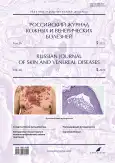The effectiveness of photodynamic therapy using a nanocapsulated oligopeptide of 5-aminolevulinic acid in the complex treatment of the genital lichen sclerosus: A case report
- Authors: Snarskaya E.S.1, Shnakhova L.M.1, Shamilova L.F.1
-
Affiliations:
- I.M. Sechenov First Moscow State Medical University of the Ministry of Health of the Russian Federation (Sechenov University)
- Issue: Vol 26, No 5 (2023)
- Pages: 477-486
- Section: DERMATOLOGY
- URL: https://journals.rcsi.science/1560-9588/article/view/232076
- DOI: https://doi.org/10.17816/dv529142
- ID: 232076
Cite item
Abstract
Lichen sclerosus et atropicus is an autoimmune dermatosis belonging to the group of localized scleroderma, most often affecting the skin of the anogenital area. The disease is characterized by slow development with chronization, visualized as areas of atrophy and induration of the affected tissues, causes unbearable itching, pain, dysuria, as well as sexual dysfunction in men and women.
The etiology of the disease has not yet been studied. However, genetic predisposition is becoming more likely, given that at least 10% of patients have a family history.
Topical corticosteroids are currently the generally accepted method of treating lichen sclerosus. Other treatments include pharmaceuticals (for example, testosterone, progesterone, tacrolimus, 5-fluorouracil and retinoids), surgical excision, cryosurgery, laser therapy and ultraviolet radiation, but none of these treatments is satisfactory and does not lead to stabilization of the skinpathological process.
A clinical case of complex effective treatment of genital lichen sclerosus et atrophicus by photodynamic photoporation using 5-aminolevulenic acid in a 19-year-old patient with a severe course of the disease, early manifestation in the neonatal period and a total vulvar skin lesion is presented.
Full Text
##article.viewOnOriginalSite##About the authors
Elena S. Snarskaya
I.M. Sechenov First Moscow State Medical University of the Ministry of Health of the Russian Federation (Sechenov University)
Author for correspondence.
Email: snarskaya-dok@mail.ru
ORCID iD: 0000-0002-7968-7663
SPIN-code: 3785-7859
MD, Dr. Sci. (Med.), Professor
Russian Federation, 8/2 Trubetskaya street, 119992 MoscowLidiya M. Shnakhova
I.M. Sechenov First Moscow State Medical University of the Ministry of Health of the Russian Federation (Sechenov University)
Email: shnakhova_l_m@staff.sechenov.ru
ORCID iD: 0000-0003-3000-0987
SPIN-code: 5549-5823
Assistant Lecturer
Russian Federation, 8/2 Trubetskaya street, 119992 MoscowLyaman F. Shamilova
I.M. Sechenov First Moscow State Medical University of the Ministry of Health of the Russian Federation (Sechenov University)
Email: lyaman.doc@gmail.com
ORCID iD: 0000-0002-7271-3910
SPIN-code: 7358-7561
Graduate Student
Russian Federation, 8/2 Trubetskaya street, 119992 MoscowReferences
- Snarskaya ES, Semenchuk AY. Scleroatrophic lichen of anogenital localization: Clinical and morphological, differential diagnostic features and complex method of treatment. Russ Med J. 2019;(12):9–12. (In Russ). doi: 10.33667/2078-5631-2019-1-7(382)-39-41
- Kirtschig G. Lichen sclerosus: Presentation, diagnosis and management. Dtsch Arztebl. 2011;108(4):53–58. doi: 10.32382Farztebl.2016.0337
- Goldstein AT, Marinoff SC, Christopher K, Srodon M. Prevalence of vulvar lichen sclerosus in a general gynecology practice. J Reprod Med. 2005;50(7):477–480.
- Snarskaya ES, Semenchuk YA. Gender and clinical and topographic features of anogenital zone lesion in patients with limited scleroderma. Russ J Skin Venereal Dis. 2020;3(23):132–145. (In Russ). doi: 10.17816/dv.233
- Fistarol SK, Itin PH. Diagnosis and treatment of lichen sclerosus: An update. Am J Clin Dermatol. 2013;14(1):27–47. doi: 10.1007/s40257-012-0006-4
- Akel R, Fuller C. Updates in lichen sclerosis: British Association of Dermatologists guidelines for the management of lichen sclerosus 2018. Br J Dermatol. 2018;178(4):823–824. doi: 10.1111/bjd.16445
- Ignatovsky AV, Agakishizade NE. Scleroatrophic lichen of the vulva and genitourinary syndrome: Issues of diagnosis and treatment. Med Alphabet. 2019;1(7):39–41. (In Russ). doi: 10.33667/2078-5631-2019-1-7(382)-39-41
- Thomas RH, Ridley CM, McGibbon DH, Black MM. Lichen sclerosus et atrophicus and autoimmunity-a study of 350 women. Br J Dermatol. 1988;118(1):41–46. doi: 10.1111/j.1365-2133.1988.tb01748.x
- Bleeker MC, Visser PJ, Overbeek LI, et al. Lichen sclerosus: Incidence and risk of vulvar squamous cell carcinoma. Cancer Epidemiol Biomark Prev. 2016;25(8):1224–1230. doi: 10.1158/1055-9965.epi-16-0019
- Fergus KB, Lee AW, Baradaran N, et al. Pathophysiology, clinical manifestations, and treatment of lichen sclerosus: A systematic review. Urology. 2019;(135):11–19. doi: 10.1016/j.urology.2019.09.034
- Lewis FM, Tatnall FM, Velangi SS, et al. British Association of Dermatologists guidelines for the management of lichen sclerosus, 2018. Br J Dermatol. 2018;178(4):839–853. doi: 10.1111/bjd.16241
- Potts BA, Belsante MJ, Peterson AC. Intraurethral steroids are a safe and effective treatment for stricture disease in patients with biopsy proven lichen sclerosus. J Urol. 2016;195(6):1790–1796. doi: 10.1016/j.juro.2015.12.067
- Neill SM, Lewis FM, Tatnall FM, Cox NH. British Association of Dermatologists’ guidelines for the management of lichen sclerosus 2010. Br J Dermatol. 2010;163(4):672–682. doi: 10.1111/j.1365-2133.2010.09997.x
- Federal clinical guidelines. Dermatovenerology, 2015: Skin diseases. Sexually transmitted infections. 5th ed., revised and updated. Moscow: Delovoi ekspress; 2016.768 р. (In Russ).
- Ozog DM, Rkein AM, Fabi SG, et al. Photodynamic therapy: A clinical consensus guide. Dermatol Surg. 2016;42(7):804–827. doi: 10.1097/DSS.0000000000000800
- Zhang Y, Su Y, Tang Y, et al. Comparative study of topical 5-aminolevulinic acid photodynamic therapy (5-ALA-PDT) and surgery for the treatment of high-grade vaginal intraepithelial neoplasia. Photodiagnosis Photodyn Ther. 2022;(39):102958. doi: 10.1016/j.pdpdt.2022.102958
- Hillemanns P, Untch M, Pröve F, et al. Photodynamic therapy of vulvar lichen sclerosus with 5-aminolevulinic acid. Obstet Gynecol. 1999;93(1):71–74. doi: 10.1016/s0029-7844(98)00321-4
- Gold MH, Goldman MP. 5-aminolevulinic acid photodynamic therapy: Where we have been and where we are going. Dermatol Surg. 2004;30(8):1077–1083; discussion 1083-1084. doi: 10.1111/j.1524-4725.2004.30331.x
- Liu J, Hao J, Wang Y, et al. Clinical and dermoscopic assessment of vulvar lichen sclerosus after 5-aminolevulinic acid photodynamic therapy: A prospective study. Photodiagnosis Photodyn Ther. 2021;(33):102109. doi: 10.1016/j.pdpdt.2020.102109
- Declercq A, Güvenç C, De Haes P. Proposition of standardized protocol for photodynamic therapy for vulvar lichen sclerosus. J Dermatolog Treat. 2022;33(1):560–568. doi: 10.1080/09546634.2020.1771260
- Maździarz A, Osuch B, Kowalska M, et al. Photodynamic therapy in the treatment of vulvar lichen sclerosus. Photodiagnosis Photodyn Ther. 2017;(19):135–139. doi: 10.1016/j.pdpdt.2017.05.011
Supplementary files










